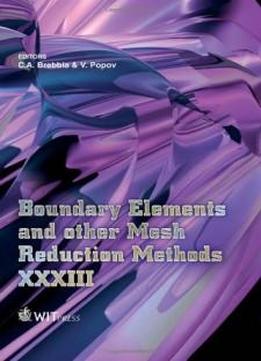
Boundary Elements And Other Mesh Reduction Methods Xxxiii (wit Transactions On Modelling And Simulation)
by C. A. Brebbia /
2011 / English / PDF
7.9 MB Download
Boundary Elements and Other Mesh Reduction Methods XXXIII contains edited versions of many of the papers presented at the 33rd International Conference on Boundary Element and other Mesh Reduction Methods, which was held on the Wessex Institute New Forest Campus in June 2011. The conference was the latest in an unusually long-lived series of annual conferences that began in 1978, covering the development of the boundary element method.
Boundary Elements and Other Mesh Reduction Methods XXXIII contains edited versions of many of the papers presented at the 33rd International Conference on Boundary Element and other Mesh Reduction Methods, which was held on the Wessex Institute New Forest Campus in June 2011. The conference was the latest in an unusually long-lived series of annual conferences that began in 1978, covering the development of the boundary element method.The boundary element method developed in the 1970s when scientists and engineers began to question the need to discretize a problem in order to find a numerical solution. It took some 10 to 15 years for the method's advantages to be clearly established, by which time the BEM had begun evolving beyond its classical formulation.
The boundary element method developed in the 1970s when scientists and engineers began to question the need to discretize a problem in order to find a numerical solution. It took some 10 to 15 years for the method's advantages to be clearly established, by which time the BEM had begun evolving beyond its classical formulation.This led to the development of meshless techniques research which has continued until today. A substantial part of the current work, however, seems to focus on finding simple solutions that may not always lead to the best results. It seems appropriate to put more emphasis on achieving robustness and accuracy, in particular when solving large engineering problems. There is a need to develop general purpose computer codes equivalent to those produced with finite elements. This requires progression from the realm of mathematical possibilities into that of engineering certainty.
This led to the development of meshless techniques research which has continued until today. A substantial part of the current work, however, seems to focus on finding simple solutions that may not always lead to the best results. It seems appropriate to put more emphasis on achieving robustness and accuracy, in particular when solving large engineering problems. There is a need to develop general purpose computer codes equivalent to those produced with finite elements. This requires progression from the realm of mathematical possibilities into that of engineering certainty.The BEM & MRM Conference is the ideal forum to discuss these and other issues which are crucial to the development of the Method. This volume is the latest to document the advances made.
The BEM & MRM Conference is the ideal forum to discuss these and other issues which are crucial to the development of the Method. This volume is the latest to document the advances made.











